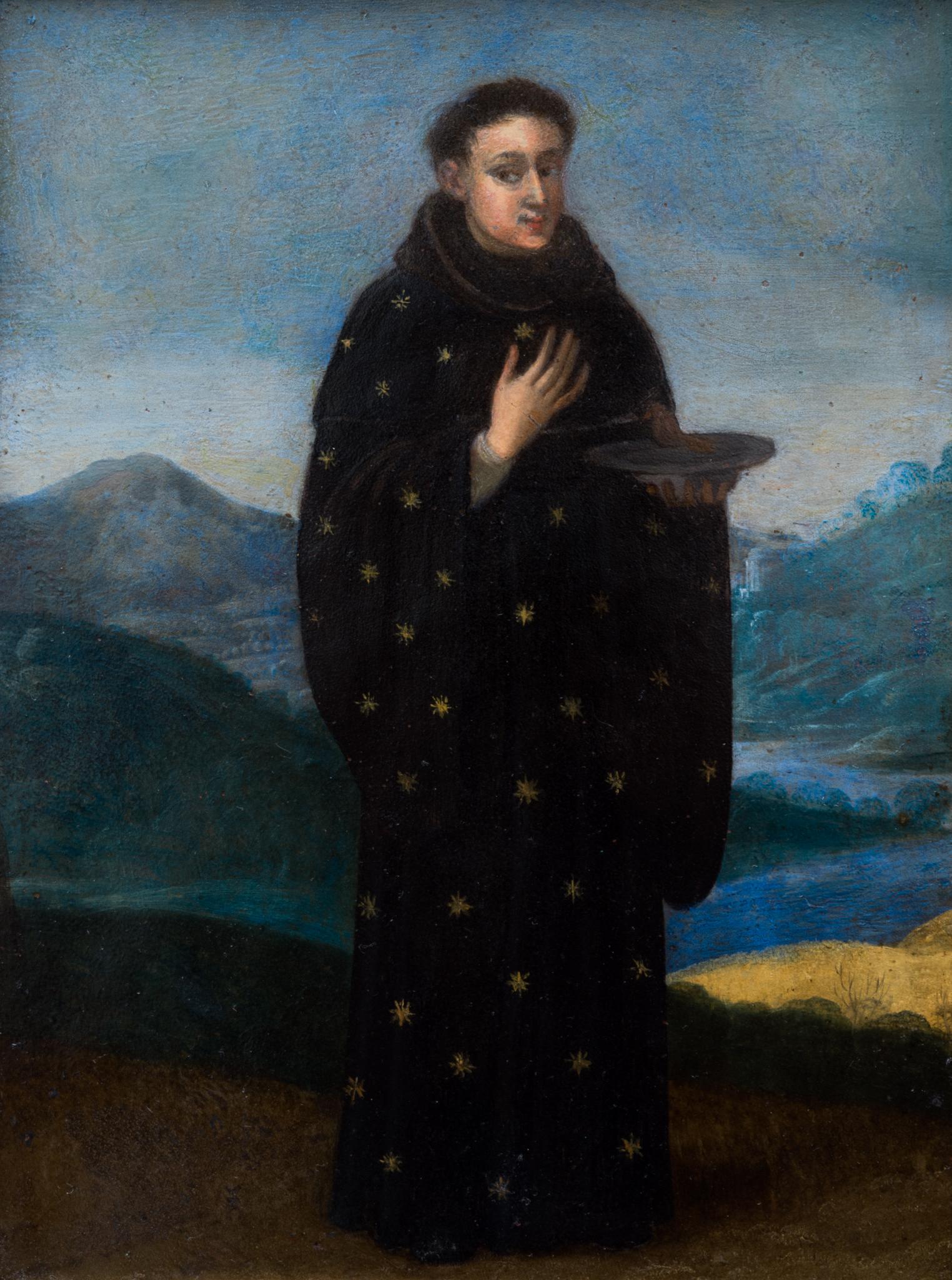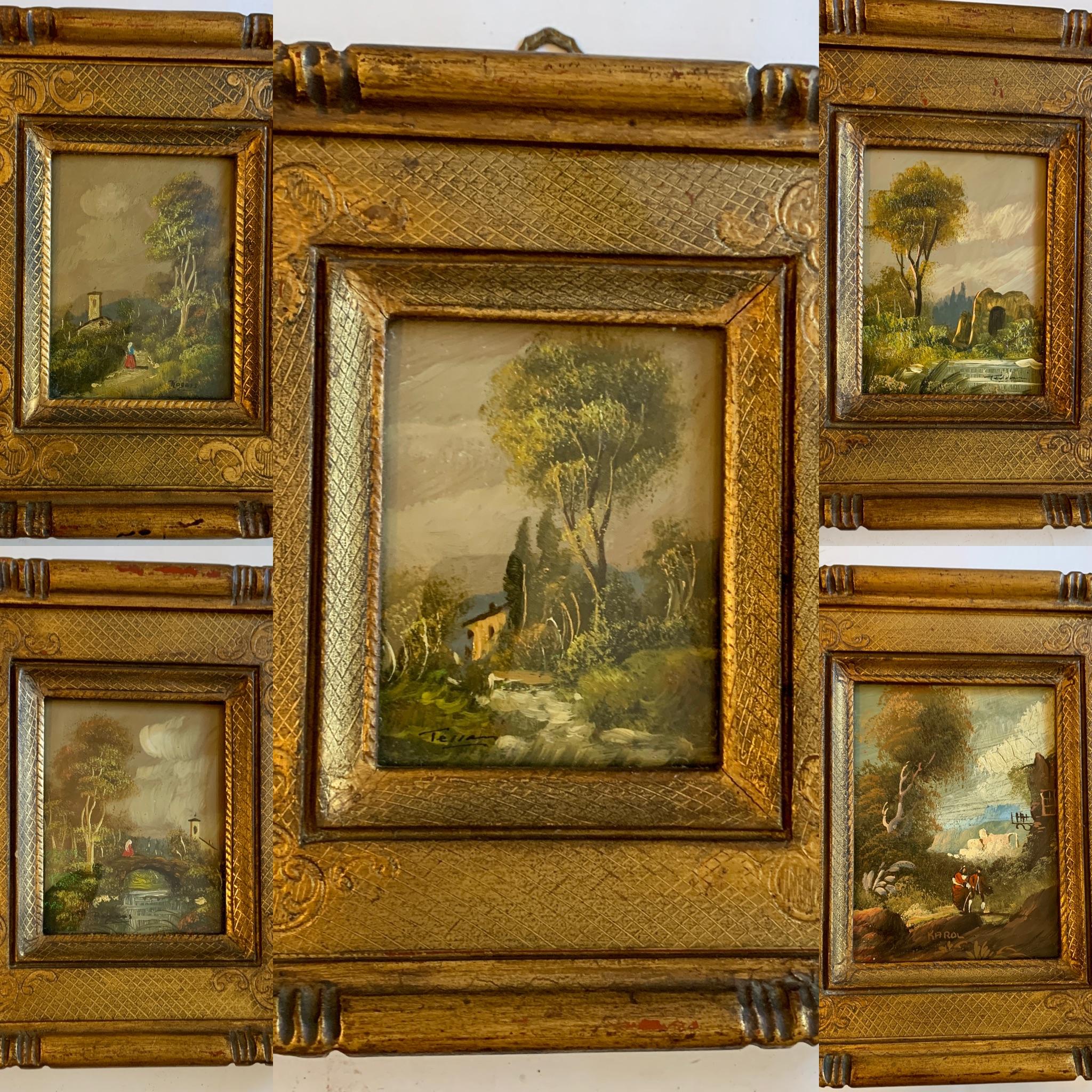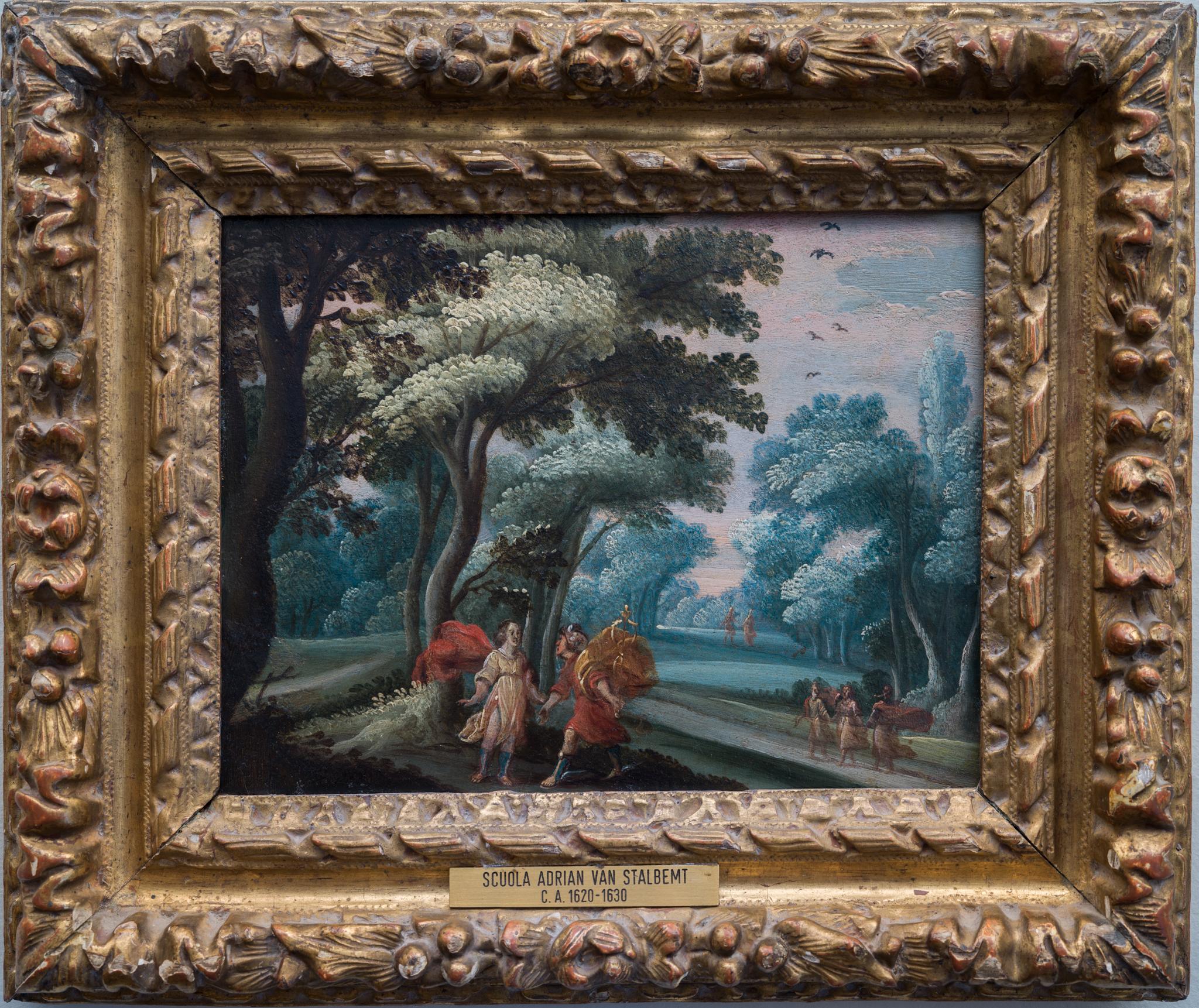Items Similar to The Adoration of the Magi by Joseph van Bredael
Want more images or videos?
Request additional images or videos from the seller
1 of 8
Joseph van BredaelThe Adoration of the Magi by Joseph van BredaelLate 17th/early 18th century
Late 17th/early 18th century
About the Item
Joseph van Bredael
1688-1739 Flemish
The Adoration of the Magi
Oil on copper
Painted on copper and exhibiting an exquisite luminosity, this exceptional painting was composed by famed Flemish artist Joseph van Bredael. Entitled The Adoration of the Magi, van Bredael masterfully tells a timeless narrative in a single image, reinterpreting the biblical scene to be quintessentially Flemish in its presentation. Exceptionally detailed and virtuosic in its composition, the painting beckons the viewer closer to examine the fine brushwork and the expansive crowd gathering in the countryside. Building on the compositions of the famed Jan Brueghel the Elder, van Bredael forges his own path, bringing his distinctive luminous palette and deft brushwork to this work of art.
Van Bredael’s The Adoration of the Magi depicts the biblical moment when the Magi present their gifts to the Christ child, as described in Matthew 2:11. Van Bredael’s composition injects new life into the time-honored tale of the three kings by placing the scene squarely in Flanders, rather than the distant lands of Bethlehem. While still centered around the illuminated figure of the infant Jesus sitting in his mother’s lap, the Magi are merely a trio of figures within the large Flemish community that gathers outside the rural barn. The distant cityscape, as well as the Magi’s richly colored and patterned robes and jewels, emphasize van Bredael’s skill as a genre painter in clearly articulating each and every detail with delicate brushwork.
A Flemish artist coming of age at the turn of the 18th century, Joseph van Bredael hails from a long line of painters. Upon moving to Paris in 1735, the artist became a member of the Académie Royale in the court of Louis, Duke of Orléans. Primarily working in landscapes and genre scenes, the highly referential artist drew from Flemish greats like Brueghel while incorporating distinctive personal touches — slender forms, light brushstrokes and a rich palette. In fact, van Bredael’s The Adoration of the Magi builds on Brueghel’s masterpiece of the same popular subject, held today at the Museum Mayer van den Bergh in Antwerp, yet maintains van Bredael’s singular style. As van Bredael signed his paintings “JB,” the same signature employed by Jan Brueghel I, many of his artworks were historically misidentified as works of the 17th-century master. Corrected attributions in recent decades have brought a burgeoning appreciation for Van Bredael’s technical prowess and meticulous eye for detail. Today, van Bredael is remembered for his talent and artistry in continuing the illustrious tradition of 17th century painting in Antwerp.
Late 17th/early 18th century
Copper: 9" high x 13 1/8" wide
Frame: 12 1/2" high x 16 3/4" wide x 1 1/2" deep
Provenance: Private collection
Private collection, Geneva, Switzerland
M.S. Rau, New Orleans
- Creator:Joseph van Bredael (1688 - 1739, Flemish)
- Creation Year:Late 17th/early 18th century
- Dimensions:Height: 12.5 in (31.75 cm)Width: 16.75 in (42.55 cm)Depth: 1.5 in (3.81 cm)
- Medium:
- Movement & Style:
- Period:Late 17th Century
- Condition:
- Gallery Location:New Orleans, LA
- Reference Number:
About the Seller
5.0
Vetted Seller
These experienced sellers undergo a comprehensive evaluation by our team of in-house experts.
Established in 1912
1stDibs seller since 2013
14 sales on 1stDibs
Typical response time: 4 hours
- ShippingRetrieving quote...Ships From: New Orleans, LA
- Return PolicyThis item cannot be returned.
More From This SellerView All
- Moses and the Pillar of Cloud by Lucas Cranach the Elder and StudioBy Lucas Cranach the ElderLocated in New Orleans, LALucas Cranach the Elder and Studio 1472-1553 German Moses and the Pillar of Cloud Oil on panel Moses and the Pillar of Cloud is a bold and evocative composition that showcases the signature intense color and intricate detail of Lucas Cranach the Elder’s celebrated oeuvre. The remarkable 16th-century oil on panel by Lucas Cranach and his studio captures the narrative moment when Moses leads the Israelites out of Egypt and encounters God manifested through a large pillar of cloud. Moses stands at the precipice of a bridge and turns back to soldiers helping to lead the group of Israelites who huddle closely together. Cranach depicts Moses with his traditional iconography, rendering the rays of light on his head which came to be interpreted as "horns" in the translation of the Bible. Using his traditional walking staff, Moses gestures toward the pillar, seemingly acknowledging that God will protect the group as they cross the bridge to the other side, leaving exile and entering a promised land. In a nod to Cranach’s Germanic locale, he renders the figures and setting in a manner that feels decisively more akin to European aesthetics than those of the Red Sea. Soldiers wear elaborate, gothic suits of armor that recall the livery of Northern European guardsmen. The terrain appears more like a European forest giving way to a sweeping valley than the arid landscape the Israelites trekked through on their journey across the Red Sea. Though still clearly recounting a story from the Old Testament, Cranach renders the cast of characters and setting in an earthly, familiar manner. This aesthetic shift speaks to Cranach’s own changing beliefs as he found himself at the center of the Protestant Reformation. After first gaining recognition in 1505 as the official painter of Frederick the Wise, Cranach established a thriving painting and print studio in Wittenberg, Germany. Cranach was renowned for his court portraits and genre paintings and was also well known for his association with the famous protestant reformer Martin Luther, then under the protection of Frederick the Wise. As Wittenberg became a bastion of new religious thought, Cranach soon befriended Luther and played an active role in creating the printed materials that proliferated throughout the Reformation...Category
16th Century Old Masters Figurative Paintings
MaterialsOil, Panel
- Dans le parc en automne, Paris (In the Park in Autumn, Paris)By Jean Francois RaffaëlliLocated in New Orleans, LAThis thoroughly modern Parisian scene was composed by the celebrated French painter Jean François Raffaëlli. The delicate oil captures a familiar subject from late 19th-century life in the city: a busy avenue at the edge of a park on a cool autumn day. Exploring the climate of the city, Raffaëlli's mature works capture the energy of the grand parks and boulevards of the new Paris that emerged at the turn of the century. His legacy documents the realities of urban life during his age, all chronicled in his distinctive brushwork and sophisticated palette. While Raffaëlli was never fully accepted as a member of the Impressionist group, his works display a similar affinity for capturing the transient moments of modern life. His figures exude a sense of being suspended in time, as though they are part of some subtle narrative that is both restless and harmonious. Perhaps more aligned with Naturalism than Impressionism, the visual effect of Raffaëlli's composition is one of carefully composed spontaneity that makes manifest the joie de vivre of the age. Raffaëlli was not the only artist of his era to devote his canvases to the urban landscape. Camille Pissarro, Claude Monet, Gustave Caillebotte and others composed significant works on the subject of the urban milieu. On the whole, it was an entirely new kind of painting, and it was largely influenced by the work of social engineer Baron Haussmann beginning in the 1850s. At the request of Emperor Napoleon III, Haussmann designed and carried out a large-scale urban renewal program, erecting landmarks and tree-lined thoroughfares throughout the city to create a unified and socially-centered urban aesthetic. The city became a glittering stage for modern advancements and bourgeois pleasure, which paved the way for a new kind of subject that was eagerly adopted by the Impressionists and artistic avant-garde. Born in Paris in 1850, Raffaëlli first studied theater and music before turning to painting in 1870. That same year, he submitted a landscape painting to the Salon and was accepted. Aside from just three months studying with the Academic great Jean-Léon Gérôme, Raffaëlli was self-trained, developing his own unique style that brought together Realism, Naturalism and Impressionism. While he managed to exhibit works at both the Salon and the Impressionist exhibitions...Category
Late 19th Century Impressionist Landscape Paintings
MaterialsBoard, Oil
- A Spring Roundelay by Edward Atkinson HornelBy Edward Atkinson HornelLocated in New Orleans, LAEdward Atkinson Hornel 1864-1933 Scottish A Spring Roundelay Signed “E A Hornel” and dated 1910 (lower left) Oil on canvas Visually arresting with the v...Category
20th Century Figurative Paintings
MaterialsOil, Canvas
- TaroudantLocated in New Orleans, LASigned, inscribed and dated "R. Pinatel / Taroudant / 1926" (lower right) Oil on panel A stunning ode to the Moroccan landscape, this oil on panel was composed by the French Orientalist painter Raphaël Pinatel, whose lively works adeptly translated the romanticism of the East for a Western audience. The present work, which captures a market in Taroudant, a city in southeastern Morocco, exemplifies the artist’s distinctive approach as he brilliantly translates the energy and atmosphere of the desert city. Pinatel’s style is impressionistic in his brushwork and handling of light and atmosphere. In the present work, he brilliantly captures the effects of the direct desert sun...Category
Early 20th Century Impressionist Landscape Paintings
MaterialsPanel, Oil
- Élégantes À Deauville By Ramon DilleyLocated in New Orleans, LARamon Dilley 1933 - Spanish Élégantes à Deauville Signed “Dilley 91” (lower right) Signed and titled “Ramon Dilley / Elegantes a Deauville” (en verso) Oil on board laid on canvas ...Category
20th Century Post-Impressionist Figurative Paintings
MaterialsCanvas, Oil, Board
- La Petite Swan By Ramon DilleyLocated in New Orleans, LARamon Dilley 1933 - Spanish La Petite Swan Signed “Dilley 91” (lower right) Signed and titled “Ramon Dilley / La Petite Swan” (en verso) Oil on board laid on canvas This captivat...Category
20th Century Post-Impressionist Figurative Paintings
MaterialsOil, Canvas, Board
You May Also Like
- Old Master Painting, Flemish School from 1600s, Saint Nicholas of TolentinoLocated in Stockholm, SEThis small Flemish painting, measuring only 24.5 x 18.5 cm and executed on a copper plate, depicts Saint Nicholas of Tolentino. Created in the 17th century, the artist remains unknow...Category
17th Century Old Masters Landscape Paintings
MaterialsCopper
- Landscape With Pan and Syrinx, Flemish School From the 1600s, Oil on CopperLocated in Stockholm, SEFlemish School, 1600s Landscape With Pan and Syrinx painted around the 1600s oil on copper 19 x 23.5 cm frame 29 x 34 cm Hand-made oak frame by Swedish frame maker Christer Björkma...Category
17th Century Old Masters Landscape Paintings
MaterialsCopper
- Five mid 20th century Italian oil landscapes with figures, castles, ChurchsLocated in Woodbury, CTA very interesting set of five mid-20th-century Italian oils on copper. All five are classical landscape subjects and are signed Roger, though we don't know which artist with the n...Category
1950s Old Masters Landscape Paintings
MaterialsCopper
- A 17th Century Mythological SceneLocated in Stockholm, SEThis small yet captivating painting, crafted on a copper plate, dates back to the mid-1600s and was created by a Flemish artist. Subject Matter: The central figure in the artwork is Mercury, easily identified by his symbolic attributes like winged sandals, petasus, and caduceus. Beside him is a likely female figure, characterized by her attire and absence of weaponry. The depicted scene could represent two mythological tales: Mercury and Calypso: This interpretation suggests the artwork shows the moment Zeus sends Mercury to Calypso's island, Ogygia. Mercury is there to order Calypso to release Ulysses, whom she saved from a shipwreck but kept captive. The lush, wooded background and the three distant figures could hint at Ulysses' farewell to Calypso. Mercury and Herses: Another interpretation could be a scene from the love story of Mercury and Herses. The background figures might symbolize the sisters returning from a procession, while the forefront could be the initial meeting between Mercury and the most beautiful sister, Erse. Artistic Inspiration: The painting's landscape and setting are heavily influenced by the early 17th century Northern European art trends, especially the works of Jan Brueghel the Elder. However, the artwork stands apart with its unique luminescence in detailing and a distinctive approach to depicting figures. While the exact origin and artist remain somewhat mysterious, the style and treatment of light hint towards works close to Josse de Momper...Category
Mid-17th Century Old Masters Figurative Paintings
MaterialsCopper
- A Pair of Forest Landscapes, Philipp H. Brinckmann, 1709 – 1761, Old MasterLocated in Bruges, BEA Pair of Forest Landscapes with River and Boat in the Foreground Brinckmann Philipp Hieronymus Spire 1709 – 1761 Manheim Old Master Signature: Signed "Ph. Brinckm" bottom lower lef...Category
18th Century Old Masters Landscape Paintings
MaterialsCopper
- 18th century Old Master oil painting - Travellers at rest in a sunset landscapeLocated in Antwerp, BE18th century old master painting depicting a peaceful countryside scenery at sunset with a fortified town visible in the distance attributed to Franz Paula de Ferg In the present je...Category
18th Century Old Masters Landscape Paintings
MaterialsCopper





